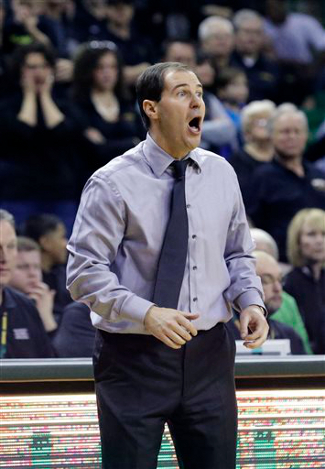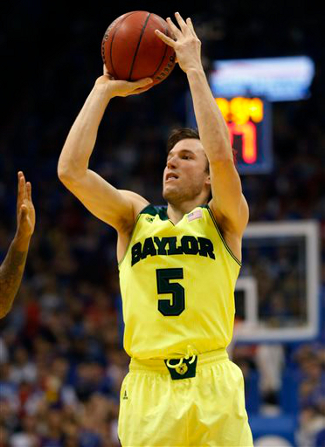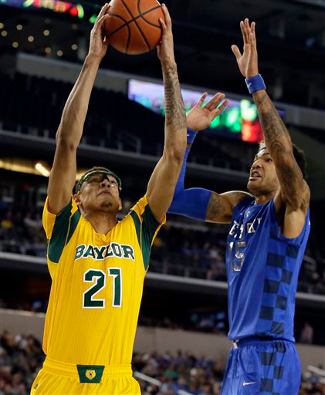#6/7 Kansas Jayhawks (16-4 overall, 7-0 Big 12) at #25/ARV Texas Longhorns (16-4, 5-2)
Erwin Center | Austin, TX | Tip: 3 P.M. CT | TV: ESPN
The Big 12’s two hottest teams meet at the Frank Erwin Center this afternoon, as the Jayhawks and Longhorns put their seven-game and five-game winning streaks on the line. Texas is returning to action after a week off, and is looking to notch its fourth consecutive win over a ranked opponent. It was a feat that had not been seen since North Carolina ran a four-game gauntlet in 1996-97, until Kansas did it just a few weeks ago. With seven different Big 12 teams bouncing in and out of the polls in conference play, the tough tests come often, but only Kansas and Texas have managed to string together lengthy winning streaks in the country’s top conference.
Texas’ streak has propelled the team from a spot on the bubble to being safely in the NCAA picture — for now. With the Big 12 schedule providing a stiff test night after night, and with the league’s three toughest road tests still to come for the Longhorns, there’s still the danger of a losing skid that could muddy Texas’ NCAA picture. Another win this afternoon over a ranked opponent — and the No. 1 team according to RPI — would give Texas even more insurance against any late-season stumbles.
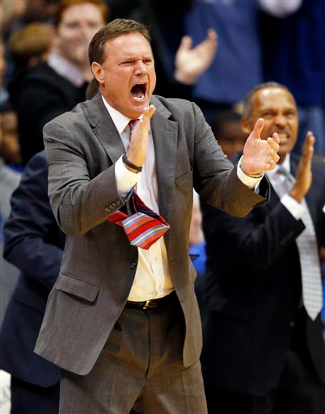
Bill Self is fired up about his team’s 7-0 Big 12 start
(Photo credit: Orlin Wagner/Associated Press)
Meanwhile, Kansas is in the hunt for a No. 1 seed in the NCAA tournament, and is already getting close to running away with another Big 12 title. With Allen Fieldhouse providing the league’s strongest home-court advantage, challengers to the throne have to pick off wins when the Jayhawks hit the road. Kansas has avoided two potential potholes already, surviving road tests in both Norman and Ames, and the team still has five games left against Texas Tech, TCU, and West Virginia.
The number of good opportunities left for Big 12 contenders to trip up the Jayhawks are dwindling, with this afternoon providing one of the best chances remaining. Considering that KU already leads Oklahoma by 1.5 games and Texas by two full games, another Jayhawk win today could make that conference lead insurmountable.
By the numbers
Kansas has the nation’s fourth-best offense when it comes to offensive efficiency, and the team does it by destroying opponents in the paint. The Jayhawks score an adjusted 1.201 points per possession, a number that has actually gone up against tougher Big 12 competition. In conference games, KU has scored 1.214 raw points per possession. On the year, Kansas averages 37.5 points per game in the paint, which makes up 46.8% of its scoring.
Kansas has an impressive frontcourt that can easily score at the rim, plus guards and wings that can get a piece of the paint. While that all leads to quite a few points in the lane, Kansas’ excellent offensive rebounding numbers also play a role in the team’s interior scoring. The Jayhawks reclaim 36.6% of their missed shots, and frequently have a player snatching up a weakside board for the easy putback.
If keeping up with that kind of offensive efficiency wasn’t tough enough for Jayhawk opponents, they also find it very difficult to score against a stout Kansas defense. KU allows 0.953 adjusted points per possession, a defensive efficiency mark that ranks 28th in the nation. That defensive dominance is thanks in large part to a block percentage of 15.8%. With a 7-foot freshman man-child starting at center, and quality depth in the KU frontcourt, opponents find it tough to score inside for the entire 40 minutes.
One area of concern for the Jayhawks is their trouble hanging on to the basketball. On the year, Kansas has coughed it up once for every five possessions, a turnover rate that is among Division I’s bottom third. In conference play, the problem has become worse, with Kansas losing the ball on 21.1% of its possessions. Against Baylor’s zone, the Jayhawks repeatedly made poor passes, and second-half backcourt pressure from Oklahoma State led to KU unraveling and a Cowboy comeback.
The fact that Kansas can give up so many possessions and still have the fourth-best offense in the country is downright frightening. If and when the Jayhawks can manage to clean up their passing, it’s hard to imagine any team being able to keep pace with their scoring.
Meet the Jayhawks
On a team with three recruits who played in the 2013 Jordan Brand Classic, Andrew Wiggins (No. 22) stands out as the freshman who arrived in Lawrence with the most hype. Although he hasn’t wowed in every single game, he has had numerous plays in each one that underscore the athleticism and talent he possesses. Wiggins has a strong, quick first step that helps him blast past defenders when he slashes from the wings, and he seems to hit another gear when he runs the open floor in transition. The freshman also loves to spin like a top when he drives from the perimeter, slipping past defenders that thought they had contained his penetration.
Wiggins has certainly struggled with his turnovers in conference play, and had a very tough time against Baylor’s zone. He looked afraid to shoot against the closing length of the Bears, and passed up numerous opportunities to drive and attack the gaps. Instead, he tried to make passes that teammates weren’t expecting, or decided to dish in midair. He coughed it up four times against Baylor, and has lost it on 21.1% of his possessions against Big 12 opponents.
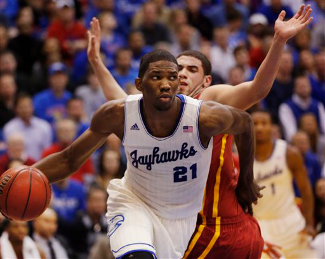
Defenses have a hard time slowing down Joel Embiid
(Photo credit: Orlin Wagner/Associated Press)
While Wiggins was the biggest freshman name for KU in the preseason, 7-foot center Joel Embiid (No. 21) has quickly become the team’s biggest star with his incredible performances. The big man only started playing basketball two years ago, but already has impeccable, smooth footwork and a variety of post moves. He understands how to get good position and take the right angles, so most defenders are beat before the entry pass is even made.
Teams have repeatedly tried to double and triple team Embiid on the catch, but he keeps the ball high and passes well against the pressure. He also uses those passing skills to his advantage in one-on-one situations, making hard pass fakes to get defenders off-balance before he moves to the rack.
Defensively, Joel has become a monster. His block rate of 12.2% ranks him 13th in the country, and he’s logged ridiculous seven and eight-block performances against UTEP and Oklahoma State. When he’s not blocking shots, he’s forcing opponents to take tough ones, and he’s constantly cleaning up the glass. Embiid is ranked in the Top 75 in both offensive (13%) and defensive (24%) rebounding percentages.
The biggest knock on Embiid’s game right now is how often he gets called for fouls, especially for throwing elbows. He was ejected for sizing up Kansas State’s Nino Williams on a rebound and popping him in the face, then earned technicals in each of the team’s next two wins, against Iowa State and Oklahoma State. While the latter two weren’t nearly as egregious as his cheap shot on Williams, Embiid now has the attention of officials, and that is going to make things a little tougher on him.
The third stud freshman is Wayne Selden, Jr. (No. 1), an excellent shooter and slasher who has been content playing sidekick to his star teammates. Coach Bill Self wasn’t as happy with that deferential attitude, and he has implored Selden to be more aggressive and take his open looks. The message finally sunk in as the calendar turned to conference play, with Wayne scoring 44 points in the team’s first two conference games, while posting an effective field goal percentage of 74.1%.
After those two solid performances, Selden went through a mini-slump. He shot just 33% from the field in the team’s next three games, including a 21.4% mark behind the arc. The cure, as it is for many teams and players, was a game against TCU. Selden shot 55.6% from the field against the Horned Frogs, scoring 12 points, while logging four assists. He followed that up with another solid outing against Iowa State on Wednesday night and seems primed to once again fill the role Coach Self envisioned for him.
At the point, senior Naadir Tharpe (No. 10) is making things click. Jayhawk fans have always been tough on the point guard, but this year he seems to be providing the quiet, steady leadership that a team of young stars needs. Tharpe’s assist rate of 30.3% is tops on the team, but he’s not simply a pass-first point guard. The senior is deadly coming off of high ball screens, as he loves to pull up and drill 18-footers.
Tharpe is also incredibly dangerous behind the arc, where he’s hit 43.8% of his long-range looks. The Jayhawks move the ball very quickly and take advantage of opponents who sell out to try to stop KU’s interior threat. Often that means swinging the ball around and hitting opposite post when teams double on the block, but it also leads to quite a few open looks for Tharpe and others waiting on the perimeter.
The fifth starter for Kansas is sophomore Perry Ellis (No. 34), a Wichita product who finally emerged as a big-time threat in last year’s Big 12 tournament. Ellis carried that momentum into this season, and he’s flourishing in the frontcourt as teams struggle to slow down Embiid. Perry has a good midrange jumper and an excellent face-up game from about 15 feet and in, plus great passing ability from the block and high post. Teams have not only tried doubling Embiid in the post, but have also thrown pressure at Ellis to try to force mistakes. Like Embiid, Ellis is able to find open teammates and get them easy looks.
While it’s tough to match the size and skillset of Kansas’ 7-foot Cameroonian center, the Jayhawks do have the luxury of a pair of solid frontcourt reserves. Jamari Traylor (No. 31) and graduate transfer Tarik Black (No. 25) are two imposing figures at 6’8″, 220 pounds and 6’9″, 260 pounds, respectively. Traylor has a really nice face-up game for a guy his size, and he also can whip some impressive passes when he puts the ball on the court and draws defensive attention with his drives.
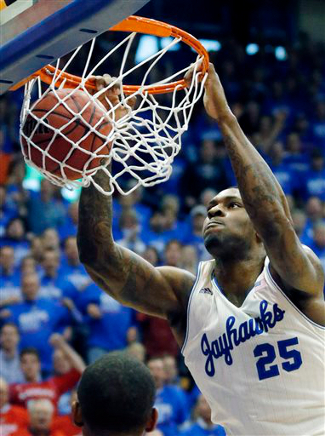
Tarik Black would be in the starting five for most teams
(Photo credit: Orlin Wagner/Associated Press)
Black turns into a wall when he sets ball screens and is a tough defender in the paint. In addition to blocking shots and cleaning up the defensive glass, he has also proven capable of planting his feet and drawing the charge, as he did three times against Kansas State earlier this year. Getting tagged with an offensive foul and turning it over is bad enough, but you have to imagine running into someone built like Black probably makes it even worse.
Unfortunately, Black sprained his ankle in a Big Monday win over Baylor and has missed the team’s last two games. He is expected to play this afternoon against Texas, but his mobility could understandably be limited. The outlook is not as good for freshman guard Conner Frankamp (No. 23), who will likely miss his second straight game due to a knee injury.
With Frankamp out, that leaves Kansas with Frank Mason (No. 0) and sparingly-used gunner Brannen Greene (No. 14) as the bench options in the backcourt. Mason, a freshman, has come on strong in recent games after struggling a bit as the team’s backup point. The 5’11” guard has a great first step and can penetrate at will, and his solid performances in Big 12 play have earned him even more playing time. Recently, Kansas has frequently put both Mason and Tharpe on the floor at once, giving the team two good ballhandlers to go with Selden or Wiggins on the wing.
Keys to the game
1) Limit offensive rebounds – Texas has done a phenomenal job on the glass this season, but the Horns have yet to face a frontcourt like this. The home loss to Oklahoma was due to Texas’ inability to clean up the defensive glass, and the team also struggled against a good-rebounding Kansas State team. The Jayhawks are already very tough to slow down, so the Longhorns must limit the number of second chances and easy putbacks that KU earns today.
2) Rotate quickly – Kansas moves the ball quickly and takes advantage of opponents who elect to double team. Cameron Ridley might find it difficult to keep up with the slippery Embiid, which means that Texas may have to risk using a second defender. If the Horns do, they will have to rotate quickly to keep up with KU’s ball movement and prevent wide open looks or easy cuts to the rim.
3) Take advantage of mistakes – The young Jayhawks have turned the ball over frequently this season, although many of their turnovers tend to be of the dead-ball variety. With Kansas boasting a strong interior defense, the Longhorns need to get as many points as they can in transition and on the secondary break. The Jayhawks gave up quite a few hoops to Oklahoma State off of turnovers, and they repeatedly lost Baylor’s Brady Heslip on the break, allowing open threes. If the Longhorns can get a nice chunk of points in the open court this afternoon, they should keep themselves in position to pull off the upset.
4) Stretch the floor – With the Jayhawks so strong inside, teams have found the most success when they can stretch the floor and pull the KU bigs out of the lane. Kansas typically rushes the ball screens with their posts, because their defense rotates well and eliminates easy buckets at the rim. However, this does leave them exposed to the pick-and-pop, something that Baylor and Isaiah Austin took advantage of last Monday. Both Jonathan Holmes and Connor Lammert have a nice three-point stroke, so the Longhorns need to exploit that tendency and have the bigs knock down a few triples after setting high ball screens.
| 










